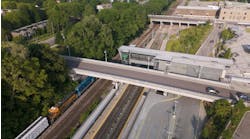USDOT to support PANYNJ Midtown Bus Terminal replacement project with $1.9 billion federal loan
The Port Authority of New York and New Jersey (PANYNJ) has been approved for a $1.9 billion federal loan through the U.S. Department of Transportation’s (USDOT) Transportation Infrastructure Finance and Innovation Act (TIFIA) Loan Program. These funds will be used for the first phase of construction for PANYNJ’s Midtown Bus Terminal replacement project. The TIFIA loan, to be issued through the Build America Bureau, will support the funding of the first phase of the $10 billion bus terminal replacement project, with construction to begin this year.
“This federal loan for this vital interstate transportation facility will enable the Port Authority to build a 21st century bus terminal that commuters from New Jersey and communities in New York City deserve and will rely on for decades to come,” said Port Authority Chairman Kevin O’Toole. “I thank our federal partners for their support for a project that will generate economic benefits for our entire region while improving the quality of life for commuters and the community where the terminal is located.”
The USDOT says the new Midtown Bus Terminal will replace the 74-year-old obsolete and deteriorated terminal with a world-class facility. The facility will help to create a more reliable and efficient bus service between New York and New Jersey which the USDOT says is critical to the interconnected economies of both states, as hundreds of thousands of New Jersey residents work in New York City. The new terminal will work to accommodate projected commuter growth between now and 2050, provide a better customer experience that serves the region’s public transportation needs and enhance the surrounding community.
“The approval of a federal TIFIA loan for this phase of our bus terminal replacement project further demonstrates the unprecedented public and governmental support at every level for our plan to replace a reviled and obsolete piece of infrastructure with a new, state-of-the-art facility that sits in the heart of Manhattan,” said Port Authority Executive Director Rick Cotton. “We are grateful to our federal partners at USDOT for working collaboratively with us throughout the process of securing this critical loan, and we are grateful for the support of our New York and New Jersey congressional delegations.” This will be the first time PANYNJ borrows from the 25-year-old TIFIA federal loan program. The agency says it will be taking advantage of subsidized loan costs and advantageous repayment terms that allow for principal and interest payments to begin up to five years following the project’s substantial completion. This will help the agency to expand its near-term cash flows and enable it to efficiently advance construction of this critical project as it continues to recover from the impacts of COVID-19 and delivers on its other critical transportation projects. PANYNJ will repay the loan using net revenues from all facilities.
In addition to the TIFIA loan, financing for the first phase of the project will include Port Authority capital funding. Future phases will also use Port Authority capital for a significant portion of the cost, funding from air/development rights for potential new commercial towers above the new bus terminal and New York City’s contribution of PILOTs generated by the Port Authority’s development efforts.
According to PANYNJ, when the project is complete the facility will include a new two million-square-foot main terminal, a separate storage and staging building and new ramps leading directly into and out of the Lincoln Tunnel.
The first phase of the project (the addition of a temporary terminal, new ramps and Dyer Avenue deck-overs) is expected to be fully completed in 2029 and the new main terminal is expected to be completed in 2032. The project plan will require the permanent closure of a portion of 41st St. between Eighth and Ninth avenues and will include a central main entrance, more street-facing retail, a multi-story indoor atrium and new public open space. PANYNJ says this plan will work to enhance both the commuter experience at the world’s busiest bus terminal and the community surrounding the facility. PANYNJ expects the project will help to create approximately 6,000 good-paying union construction jobs.
PANYNJ’s plan for the replacement of the Midtown Bus Terminal reflects public feedback from extensive community outreach, including input from New York City, commuters, local community boards and elected officials in both states. The federal record of decision permits construction of a full three-part building plan and deck-overs that will be converted to publicly accessible open space once the new main terminal is completed. The PANYNJ Board of Commissioners approved construction contracts for the deck-overs in July, which were the first contracts associated with the bus terminal replacement project. The project also includes a wide array of community benefits, including:
- Added capacity to allow curbside inter-city buses that currently pick up and drop off on city streets surrounding the bus terminal to move their operations inside the bus terminal and off the streets.
- The new staging and storage facility will consolidate storage and staging functions in a single facility, minimizing bus idling and circulation around local city streets and reducing congestion in and out of the Lincoln Tunnel.
- The creation of 3.5 acres of publicly accessible green spaces on Port Authority property by building platforms spanning the currently below-grade Dyer Avenue “cut” and turning the open space on top of the new deck-overs into public green spaces at the end of construction.
- New concessions and retail amenities that will be accessible from the streets in the community as well as from inside the bus terminal.
The plan eliminates the taking of private property as it would be built on existing Port Authority property stretching as far west as 11th Avenue.
The new bus terminal will be built for the future and designed to be net-zero emissions, accommodating all-electric bus fleets and implementing better technology. The building will also include new sustainability and resiliency measures, from LEED certification and clean construction to onsite renewable energy, zoned heating and cooling systems and heat recovery and reuse technology.
“It’s important to acknowledge the impact that this project will have on the community and the Port Authority’s innovative approach to make this long-planned project finally become a reality,” said Build America Bureau Executive Director Morteza Farajian, Ph.D. “By using TIFIA and embracing innovative financing, the Port Authority will provide a state-of-the-art, reliable and efficient bus facility much sooner than it otherwise could.”
The new ramp structure will provide a direct connection to the Lincoln Tunnel, with added queue space and bypass capability, thereby reducing bus circulation on local city streets. Community-friendly outward-facing local retail will benefit commuters and the community alike.

Eman Abu-Khaled | Associate Editor
Eman Abu-Khaled is a graduate of Kent State University with a bachelors in journalism. She works through Endeavor Business Media with Mass Transit as an associate editor. Abu-Khaled brings a fresh perspective to the visual side of journalism with an interest in video and photography work.






